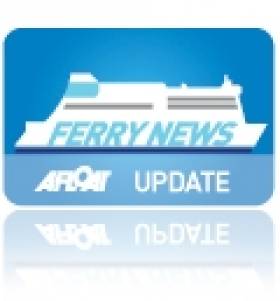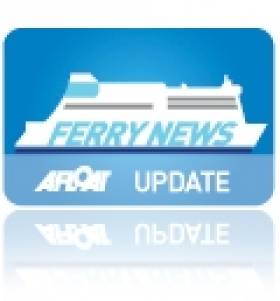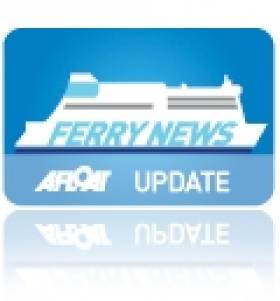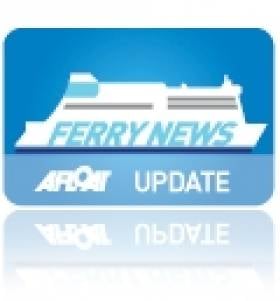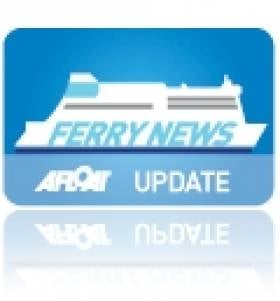Displaying items by tag: P&O Ferries
P&O 'Express' Service Nears End of Season Sailings
#P&Oexpress- P&O Ferries seasonal-only operated Larne-Troon route is scheduled to cease next Monday (7 October) bringing a close to this year's Northern Ireland-Scotland route, writes Jehan Ashmore.
The route operated by the InCAT 91m fast-craft P&O Express completes the crossing in 2hours 15 minutes. As part of a £20m plus investment of P&O Ferries Irish Sea fleet and ports, this season saw a new Club Lounge installed on the 920 passenger / 225 car capacity fast-craft.
In addition the Club Lounge also features on board Larne-Cairnryan route conventional ro-pax sisters European Causeway and European Highlander. The Japanese built pair complete the Northern Channel crossing in 2 hours.
Northward of Troon is another ferryport, Ardrossan where as previously reported, the last sailing of Caledonian MacBraynes new 'seasonal' service to Campbeltown on the Mull of Kintyre took place yesterday. The Ayrshire port is better known for its year-round service to Brodick on the Isle of Arann.
Countdown to P&O Express Scottish Service
#P&OExpress – A month to go sees the return of P&O Ferries fastcraft 'Express' service on the two-hour Larne-Troon route, which operates from 27 March to October.
The P&O Express (1998/5,902grt) accommodates more than 800 passengers and nearly 200 vehicles on the short hop across the North Channel linking Antrim and Ayrshire. The fastcraft also operates on certain sailings in tandem with ro-pax ferries running on the Larne-Cairnryan route.
On board facilities include a Fables Restaurant, the Harbour Coffee Company and for shoppers at sea, a stroll around the spacious Seashop.
Like other Irish Sea fast-ferries during the winter months, these vessels would go into 'hibernation' mode. As for the Austal built Express 91m craft completed in Fremantle, she spent several months lying in Belfast Harbour.
For further details of the P&O Express service on the Larne-Troon service click HERE.
P&O Ferries Protests Over Eurotunnel Bid to run French Ports
#StraitofDover– Dover's largest ferry operator P&O Ferries have written to the UK Office of Fair Trading, expressing concern over Eurotunnel's inclusion in a final round process to manage French shortsea ports Calais and Boulogne.
The Channel Tunnel operator's move could lead to 'substantial lessening of competition' in shortsea services between the UK and France.
Chief executive of P&O Ferries, Helen Deeble, said a successful bid by the Channel Tunnel operator could lead to a "substantial lessening of competition" in shortsea services between the UK and France.
Calais and Boulogne, owned by the Nord Pas de Calais Chamber of Commerce, comprise two of the three French shortsea ports serving ro-ro traffic out of the UK.
Ms Deeble, who is also the current president of the UK Chamber of Shipping, said a successful Eurotunnel bid would amount to a "relevant merger" within the Enterprise Act 2002, providing grounds for the OFT to investigate.
P&O Ferries, owned by Dubai World, further argues that the ports of Calais and Boulogne "would cease to be distinct from Eurotunnel" and that £70m ($109.8m) of UK derived turnover would be acquired by Eurotunnel.
As a result, said P&O Ferries: "More than 25% of France-based French sea port services for ex-UK ferry traffic is or will be provided by a single entity, Eurotunnel."
For much more on this story Lloyd's List has a report.
P&O Invest in Major Upgrade of Scottish Ferryport
#FerryPort – Work has begun on a major upgrade of the Scottish ferryport of Cairnryan, on Loch Ryan, according to The Irish News.
The renovation of part of the P&O Ferries division-owed port comes after rival Stena Line invested millions in its terminal in Belfast. As recently referred on Afloat.ie, Stena also invested heavily in recent years with a brand new facility just outside Cairnryan.
While the project will mean improved services for those using the ferry crossing, it is also good news for the Northern Ireland construction industry. Work will be carried out by Belfast-based civil engineering contractors McLaughlin and Harvey.
A new roll-on and roll-off linkspan is to be installed at the port with work expected to be complete by the end of the year. This replacement floating ramp structure will be used by freight and tourist vehicles shipping with P&O Ferries' services to and from Larne.
Irish Sea Central Corridor Ferry Operators Prepare For Seasonal Boost
#FERRY NEWS – Over the busy festive season and during the early New Year periods, Irish Sea 'central corridor' route ferry operators are preparing for an influx of passengers, writes Jehan Ashmore.
Stena Line's HSS Fastcraft will return on the Dun Laoghaire-Holyhead route for the festive season with the following sailing schedule: 20-23 December, 27-30 December and between 2-5 January 2013.
The route is served by the HSS Stena Explorer fastcraft with a crossing time of 1 hour 20 minutes. For further information about the service, click here.
In addition Stena Line operate sailings on the Dublin Port-Holyhead route, which is served by two conventional superferries, Stena Adventurer and Stena Nordica on the 3 hours 15 minute service. For further details click here.
Irish Ferries Dublin Port-Holyhead route is served by cruise ferry Ulysses and fast ferry Jonathan Swift, though for the festive period the cruise ferry, Isle of Inishmore will be introduced to provide an extra sailing in each direction on the following dates: 22, 23 and 27 December and 2 and 3 January 2013.
Passage times on the route for the cruise-ferries take 3 hours 15 minutes and the fast ferry crossing is 1 hour 49 minutes. For more information and sailing times click here.
Also running service on the central corridor is P&O Ferries Dublin Port-Liverpool route which is served by a trio of ro-pax ferries, European Endeavour and sisters Norbank and Norbay.
They operate to a crossing time of between 7 hours 30 minutes and 8 hours 5 minutes, which varies subject to sailing times. On this route, the service does not cater for foot passengers. Details of this service can be found on their website here.
#P&O 175th ANNIVERSARY – The cruiseship Arcadia (2005/83,781grt) sailed into Dublin Port after an overnight passage from Southampton, where P&O celebrated their 175th anniversary on Tuesday with a spectacular parade of the fleet billed as the 'Grand Event', writes Jehan Ashmore.
Dublin Port is the first port of call since the 2,388 passenger (maximum) capacity Arcadia departed her homeport on a 14-night adult-only round trip cruise to Iceland. She and six cruiseships of the P&O Cruise fleet formed the impressive sail past down the Solent to where they each went their separate ways on cruising intineries.
The Peninsular and Oriental Steam Navigation Company, better known throughout the world as P&O was established in 1837. The famous company's colourful house-flag is flown on the P&O Cruises fleet and P&O Ferries operating out of the UK. The flag is also depicted as the funnel colours of the ferry fleet and incorporates the royal colours of Spain (red and gold) and Portugal (blue and white) which relate to the older traditional colours representing the monarchy.
In 2005 P&O was sold to Dubai based DP World for £3.3 billion, which operates P&O Ferries, while the cruise division was sold off to Carnival UK, a subsidiary of the US owned Carnival Corporation which among its many companies includes Cunard Line. The Arcadia and her fleetmates are under the P&O Cruise brand and the cruiseships also fly the house-flag under license.
The origins of P&O though can be traced as far back to 1815 when Brodie McGhie Wilcox engaged Arthur Anderson to become a ship clerk in his brokerage business in London. The Lime Street based brokerage initially chartered vessels and the business grew so by 1823 Anderson was made a partner to form Wilcox and Anderson. They embarked on a sail-cargo service from London to the Iberian Peninsula.
In 1835 the timber-built passenger and cargoship paddle steamer William Fawcett was chartered from the Dublin and London Steam Packet Company. The 206-tonne vessel gave a top speed of 10 knots, noting that she had two sailing masts fore and aft of the steamer's funnel.
William Fawcett is regarded to be the first ship in the P&O fleet, the steamer with the Irish connection carried the government contract to carry 'mails' to Iberia. The company secured more contracts and rapid expansion to the Orient, where the house-flag reached India, Ceylon, Penang, Singapore, Hong Kong and Australia. This led to many ships built and not just confined to cargoships, notably the liners with passengers travelling Port-Out and Starboard-Home...how POSH indeed!
It was fitting to see Arcadia arrive into a flat-calm Dublin Bay as she entered from the southern approaches off Dalkey Island, where paddle-steamers such as William Fawcett would of sailed past heading for London. Her modern short-sea successor in the form of P&O Ferries ro-pax European Endeavour (2000/ 22,125grt) was also arriving into the bay off the Baily lighthouse from Liverpool.
Arcadia cost £200m to build and when the vessel was laid down at the Fincantieri Cant. Nav. Italiani SpA shipyard in Monfalcone, she was originally the Queen Victoria for Cunard Line. It was however decided that the newbuild would be renamed Arcadia as she was transferred by Carnival to the P&O Cruises brand and given a traditional name.
To read more about the company, the ships and much more visit www.poheritage.com
Port Out Starboard Home as Olympic Torch Travels P&OSH
#OLYMPIC FERRY– With 50 days to go to the start of the London Olympic Games, the torch-relay is to depart Northern Ireland this afternoon with P&O Ferries on the North Channel service to Scotland, writes Jehan Ashmore.
Before the flame reaches the Port of Larne, 67 torch-bearers will have carried the torch today on a near 120 mile journey across the north having departed Newcastle this morning.
A highlight of the day was a water crossing on Lough Neagh, where the flame was carried by the boat Island Warrior on the largest lake on the island of Ireland. Eorann O'Neil from Crumlin had the honour of torch-bearer and the 16 year-old was nominated for his dedication to swimming.
When the torch with its accompanying escort of support vehicles arrives in Larne mid-afternoon, the flame will be taken to an event to mark it leaving Northern Ireland. An hour later the torch's motorcade is to head for the port to board the P&O conventional ferry European Highlander on the 16.30hrs sailing for Cairnryan in Galloway. The 21,188grt ferry will arrive at the port on Lough Ryan some two hours later.
Tomorrow morning sees the start of the first relay in Scotland which is scheduled to start at 06.08hrs and takes place further down along Lough Ryan at the former ferryport of Stranraer.
The ferryport closed last November when Stena Line switched Scottish ferry terminals to Cairnryan, where sailings to Belfast are still maintained by a pair of 30, 285grt 'Superfast' sisters. Close to the new €80m Stena terminal is the existing terminal that serves P&O's operations.
Tomorrow's torch returns to Cairnryan as the relay route heads northwards to Glasgow which marks the day's final destination. After the torch completes touring Scotland the relay will cross the border to England to head back to London 70 days after originally embarking on a tour of the UK and detour to Dublin. The capital has been the only location visited by the torch relay outside that of the UK and Greece.
Ferry For Falmouth
#FERRY NEWS – European Endeavour (2000/ 24,046grt), the largest of three ferries running for P&O's Dublin-Liverpool route departed from the capital's port this afternoon bound for A&P Groups dry-dock facility in Falmouth, writes Jehan Ashmore.
The former Dover-Calais serving ferry started working on the Irish Sea on a full-time basis last year as previously reported. Her fleetmates are the 17,000 tonnes sisters Norbank and Norbay.
The trio of ro-pax ferries are to a design where freight is predominately the main cargo and passenger capacity is reduced considerably compared to most conventional ferries. European Endeavour can handle 130 lorries and accommodate 210 passengers whereas her fleetmates are the reverse with greater freight capacity for 150 freight units and a reduced capacity for 114 passengers.
P&O are the only ferry firm on the route providing passenger and car ferry service though they do not cater for 'foot' passengers. Their rivals Seatruck Ferries offer the only dedicated freight-operation on a network of routes on the north Irish Sea including the Liffey-Mersey link, where in recent months new tonnage has entered service.
Seasonal Start for Three In A Row
#FERRY NEWS – By this weekend three seasonal-only operated routes from the island of Ireland will have resumed service since the recent change of the clocks marking the start of summertime, writes Jehan Ashmore.
Sailings started today on Stena Line's Dun Laoghaire-Holyhead (120 minutes) fast-craft HSS Stena Explorer operated service. The central corridor route closed last September due to cost-saving measures as previously reported. For further details on sailing schedule click HERE.
The reopening of the Welsh route follows yesterday's launch of P&O Ferries fast-craft sailings to Scotland between Larne-Troon (2 hours) served by the 92m Express. She also runs additional sailings on the year-round Larne-Cairnryan route served by a pair of conventional ferry sisters. To read more information on both sailing route schedules click HERE.
The remaining route to re-open is Brittany Ferries Cork-Roscoff (14 hours) service operated by the 2,400 passenger 'flagship' Pont-Aven, which features an indoor swimming pool. Her first sailing for this year is tonight's sailing from the Breton port.
The corresponding Irish sailing departs tomorrow afternoon and the inaugural round trip is due to be completed with an arrival in France on Sunday morning. For sailing times click HERE.
Early Start for 'Ferry Fortnight'
#FERRY NEWS – St.Patrick's Day coincides with the start of the UK's annual National Ferry Fortnight (17-30 March) campaign which includes the participation of over 50 routes, including those operating on the Irish Sea, writes Jehan Ashmore.
This year's event organised by the Passenger Shipping Association (PSA) is to be brought forward two months earlier instead of May. According to the PSA the change of dates was designed to "emphasise the great value of family ferry travel at a time when parents have a watchful eye on budgets".
A new official logo will front the campaign's website www.discoverferries.com which is supported by all ferry line members of the association. The two week showcase aims to heighten consumer and media awareness of the UK's extensive ferry firms route network.
PSA members include Brittany Ferries, Condor Ferries, DFDS Seaways, Hovertravel, Isle Of Man Steam Packet Company, Irish Ferries, LD Lines, P&O Ferries, Red Funnel, Stena Line and Wightlink.
The association estimate that around 35 million people, 8 million cars and 140,000 coaches were carried by ferries last year.




























